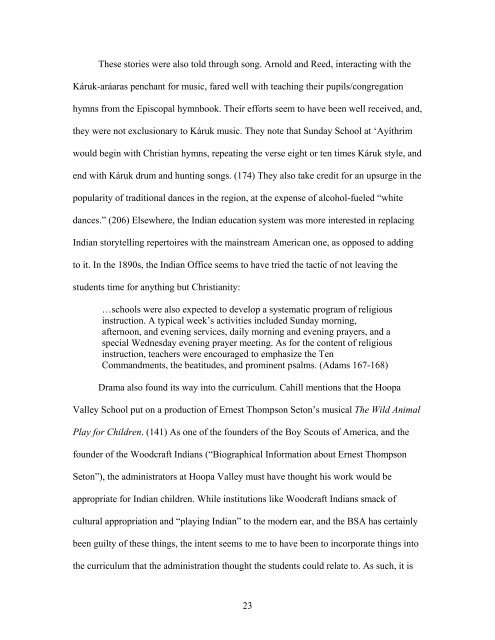The Intersection of Karuk Storytelling and Education
The Intersection of Karuk Storytelling and Education
The Intersection of Karuk Storytelling and Education
Create successful ePaper yourself
Turn your PDF publications into a flip-book with our unique Google optimized e-Paper software.
<strong>The</strong>se stories were also told through song. Arnold <strong>and</strong> Reed, interacting with the<br />
Káruk-aráaras penchant for music, fared well with teaching their pupils/congregation<br />
hymns from the Episcopal hymnbook. <strong>The</strong>ir efforts seem to have been well received, <strong>and</strong>,<br />
they were not exclusionary to Káruk music. <strong>The</strong>y note that Sunday School at ‘Ayíthrim<br />
would begin with Christian hymns, repeating the verse eight or ten times Káruk style, <strong>and</strong><br />
end with Káruk drum <strong>and</strong> hunting songs. (174) <strong>The</strong>y also take credit for an upsurge in the<br />
popularity <strong>of</strong> traditional dances in the region, at the expense <strong>of</strong> alcohol-fueled “white<br />
dances.” (206) Elsewhere, the Indian education system was more interested in replacing<br />
Indian storytelling repertoires with the mainstream American one, as opposed to adding<br />
to it. In the 1890s, the Indian Office seems to have tried the tactic <strong>of</strong> not leaving the<br />
students time for anything but Christianity:<br />
…schools were also expected to develop a systematic program <strong>of</strong> religious<br />
instruction. A typical week’s activities included Sunday morning,<br />
afternoon, <strong>and</strong> evening services, daily morning <strong>and</strong> evening prayers, <strong>and</strong> a<br />
special Wednesday evening prayer meeting. As for the content <strong>of</strong> religious<br />
instruction, teachers were encouraged to emphasize the Ten<br />
Comm<strong>and</strong>ments, the beatitudes, <strong>and</strong> prominent psalms. (Adams 167-168)<br />
Drama also found its way into the curriculum. Cahill mentions that the Hoopa<br />
Valley School put on a production <strong>of</strong> Ernest Thompson Seton’s musical <strong>The</strong> Wild Animal<br />
Play for Children. (141) As one <strong>of</strong> the founders <strong>of</strong> the Boy Scouts <strong>of</strong> America, <strong>and</strong> the<br />
founder <strong>of</strong> the Woodcraft Indians (“Biographical Information about Ernest Thompson<br />
Seton”), the administrators at Hoopa Valley must have thought his work would be<br />
appropriate for Indian children. While institutions like Woodcraft Indians smack <strong>of</strong><br />
cultural appropriation <strong>and</strong> “playing Indian” to the modern ear, <strong>and</strong> the BSA has certainly<br />
been guilty <strong>of</strong> these things, the intent seems to me to have been to incorporate things into<br />
the curriculum that the administration thought the students could relate to. As such, it is<br />
23
















